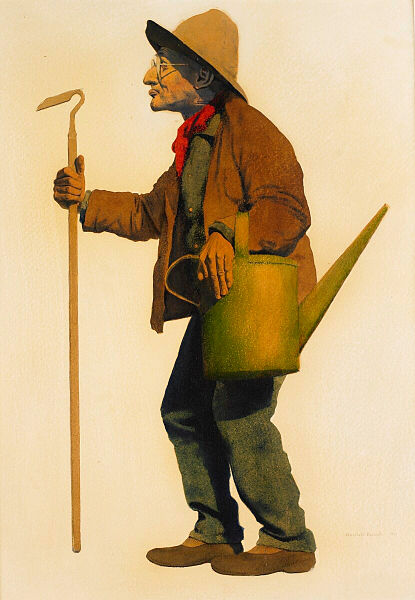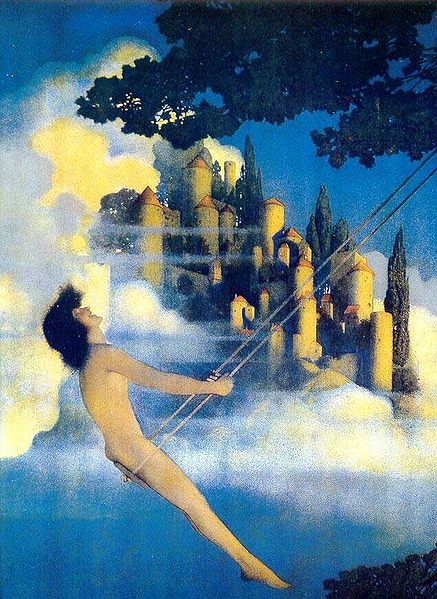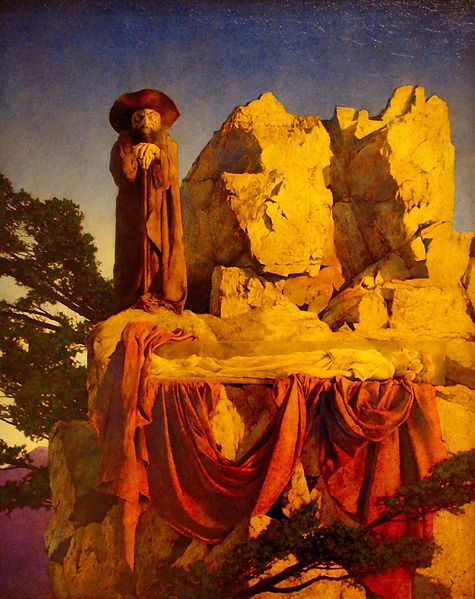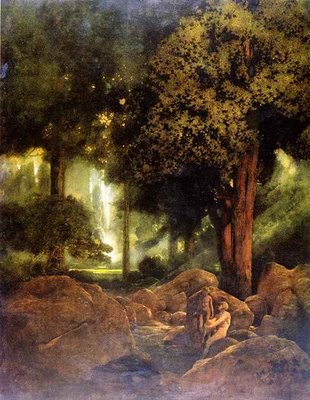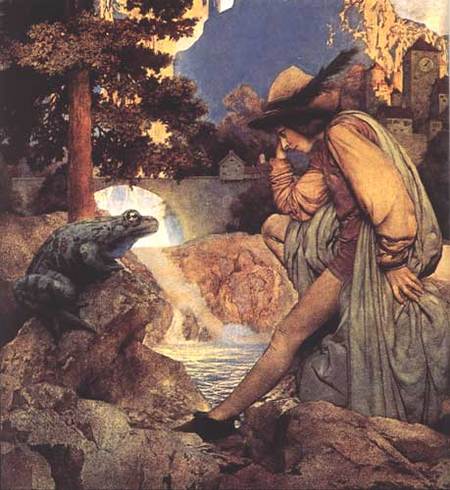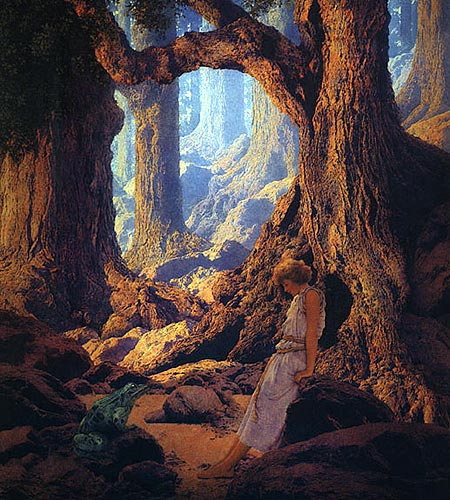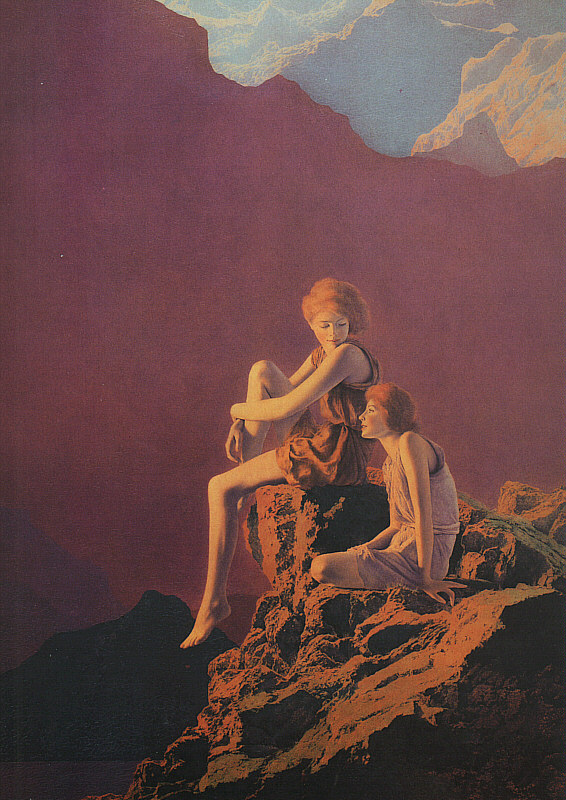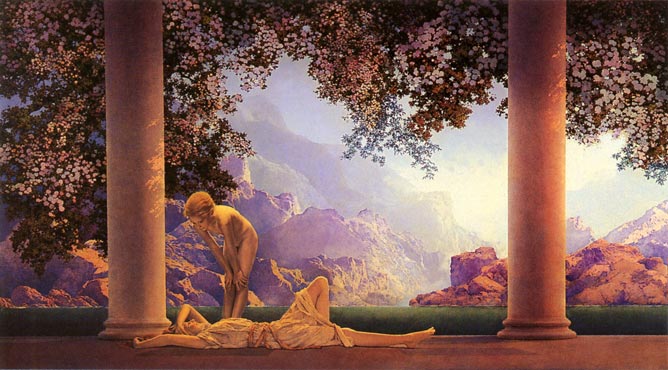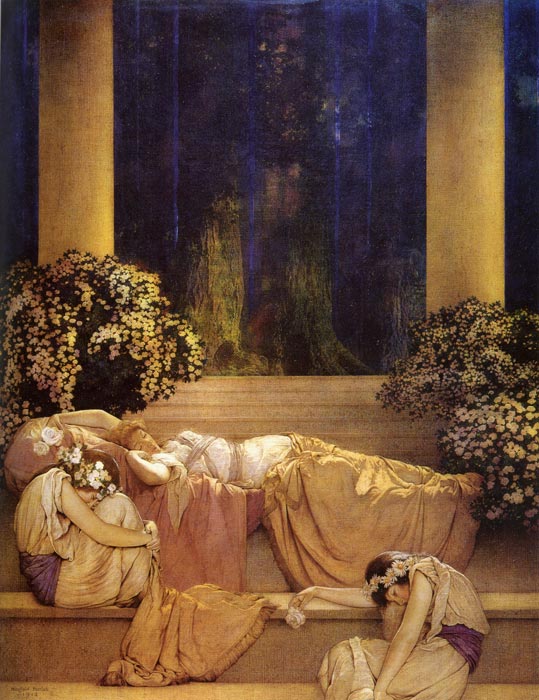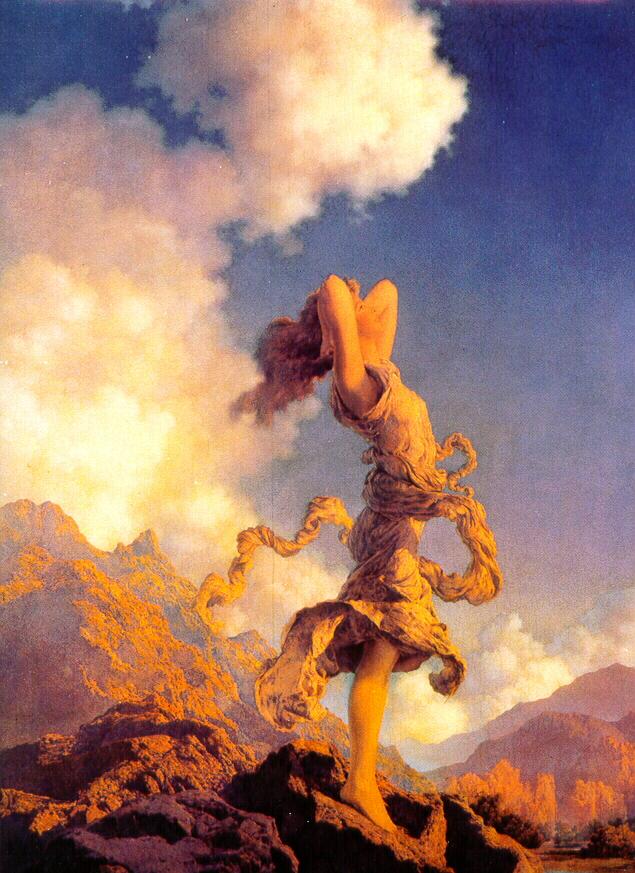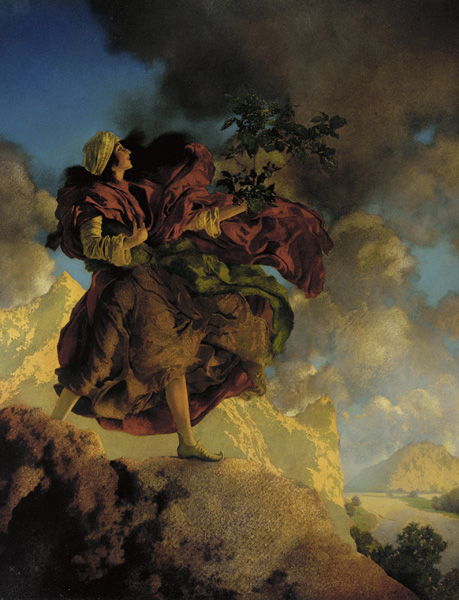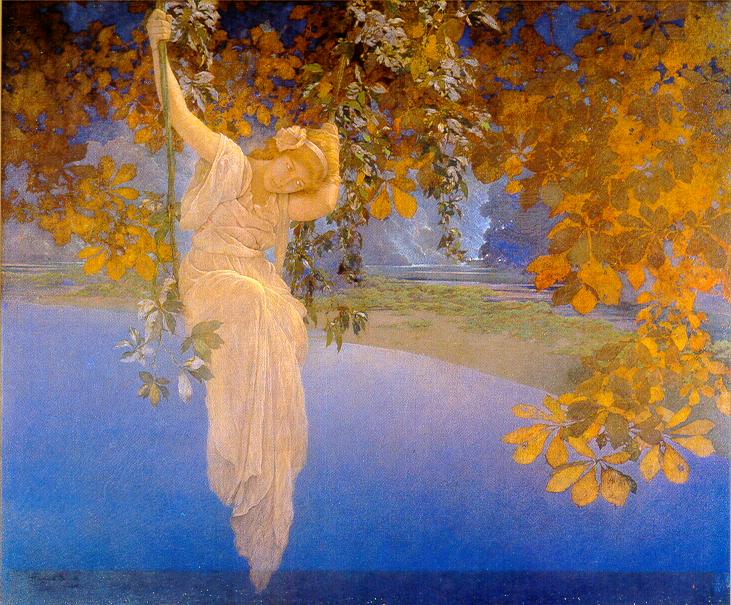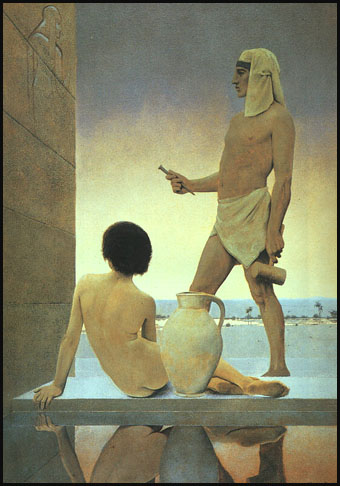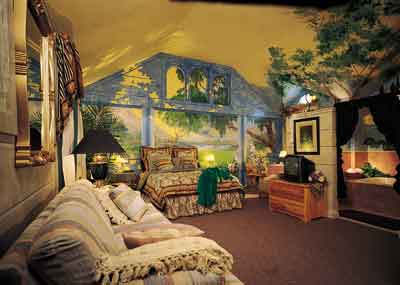<Back to Index>
- Mathematician Johann Benedict Listing, 1808
- Painter Maxfield Parrish, 1870
- Daimyō of the Edo Katō Kiyomasa, 1562
PAGE SPONSOR
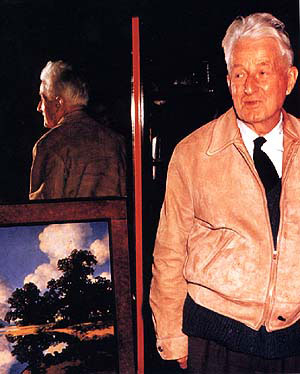
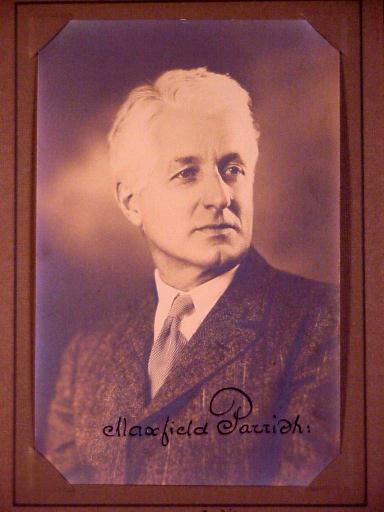
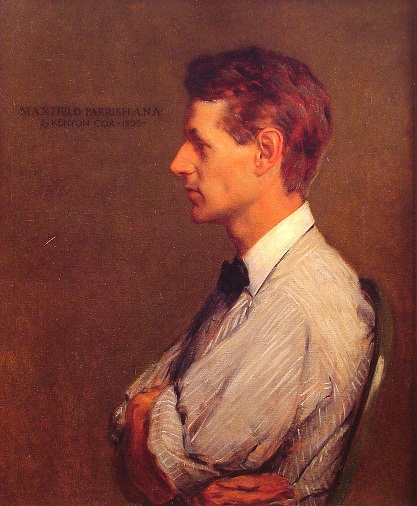
Maxfield Parrish (July 25, 1870 – March 30, 1966) was an American painter and illustrator active in the first half of the twentieth century. He is known for his distinctive saturated hues and idealized neo - classical imagery.
Born in Philadelphia, Pennsylvania, he was the son of painter and etcher Stephen Parrish. He began drawing for his own amusement as a child. His given name was Frederick Parrish but he later adopted the maiden name of his paternal grandmother, Maxfield, as his middle name, and later as his professional name. His father was an engraver and landscape artist, and young Parrish's parents encouraged his talent. He attended Haverford College, the Pennsylvania Academy of the Fine Arts, and Drexel Institute of Art. He entered into an artistic career that lasted for more than half a century, and which helped shape the Golden Age of illustration and the future of American visual arts.
He
lived his entire adult life at his New Hampshire home / studio at The
Oaks with his wife, who died in 1953, and his mistress and model, Sue
Lewin, who survived his death in 1966 at age 95. He was by all accounts
a charming and intelligent man whose writings add a great deal to the
text in Ludwig's biography of him. Launched by a commission to illustrate L. Frank Baum's Mother Goose in Prose in 1897, his repertoire included many prestigious projects including Eugene Field's Poems of Childhood (including 8 color plates) (1904) and such traditional works as Arabian Nights (including
12 color plates) (1909). Books illustrated by Parrish, in addition to
those that include reproductions of Parrish's work — including A Wonder Book and Tanglewood Tales (including 10 color plates) (1910), The Golden Treasury of Songs and Lyrics (including 8 color plates) (1911) and The Knave of Hearts (including 23 color images) (1925) – are highly sought - after collectors items. He had numerous commissions from popular magazines in the 1910s and 1920s including Hearst's, Colliers, and Life. He was also a favorite of advertisers, including Wanamaker's, Edison - Mazda Lamps, Fisk Tires, Colgate and Oneida Cutlery. In the 1920s, Parrish turned away from illustration and concentrated on painting for its own sake. Androgynous nudes in fantastical settings were a recurring theme. He continued in this vein for several years,
living comfortably off the royalties brought in by the production of posters and calendars featuring
his works. An early favorite model was Kitty Owen in the 1920s. Later
another favorite, Susan Lewin, posed for many works, and was employed
in the Parrish household for many years. Parrish himself posed for many
images that featured male — and occasionally female — figures. In 1931, he declared to the Associated Press,
"I'm done with girls on rocks", and opted instead to focus on
landscapes. Though never as popular as his earlier works, he profited
from them. He would often build models of the landscapes he wished to
paint, using various lighting setups before deciding on a preferred
view, which he would photograph as a basis for the painting. He lived in Plainfield, New Hampshire, near the Cornish Art Colony, and painted until he was 91 years old. He was also an avid machinist. Parrish's art features dazzlingly luminous colors; the color Parrish blue was named in acknowledgement. He achieved the results by means of a technique called glazing where bright layers of oil color separated by varnish are applied alternately over a base rendering (Parrish usually used a blue and white monochromatic underpainting). He
would build up the depth in his paintings by photographing, enlarging,
projecting and tracing half - or full - size objects or figures. Parrish
then cut out and placed the images on his canvas, covering them with
thick, but clear, layers of glaze. The result is realism of elegiac
vivacity. His work achieves a unique three - dimensional appearance,
which does not translate well to coffee table books. The
outer proportions and internal divisions of Parrish's compositions were
carefully calculated in accordance with geometric principles such as root rectangles and the golden ratio. In this Parrish was influenced by Jay Hambidge's theory of Dynamic Symmetry. Parrish
devised many innovative techniques which no other major artist has
successfully copied. A technique which Parrish used frequently involved
creating a large piece of cloth with a geometric pattern in stark
black - and - white (such as alternate black and white squares, or a
regular pattern of black circles on a white background). A human model
(often Parrish himself) would then pose for a photograph with this
cloth draped naturally on his or her body in a manner which
intentionally distorted the pattern. Parrish would develop a
transparency of the photo, then project this onto the canvas of his
current work in progress. Using black graphite on
the white canvas, Parrish would painstakingly trace and fill in all the
black portions of the projected photo. The result was astonishing: in
the finished painting, a human figure would be seen wearing a
distinctive geometrically - patterned cloth which draped realistically
and accurately. Parrish's work defies categorization since
he was part of no traditional movement or school, and developed an
original and individual style. However, his work has been highly
influential. The Elton John album Caribou has a Parrish background. The Moody Blues album The Present uses a variation of the Parrish painting Daybreak for its cover. In 1984, Dali's Car, the British New Wave project of Peter Murphy and Mick Karn, used Daybreak as the cover art of their only album, The Waking Hour. The Irish musician Enya has been inspired by the works of Parrish. The cover art of her 1995 album The Memory of Trees is based on his painting The Young King of the Black Isles. A number of her music videos include Parrish imagery including Caribbean Blue. In the 1995 music video "You Are Not Alone", Michael Jackson and his then wife Lisa Marie Presley appear semi - nude in emulation of Daybreak. The cover of the 1985 Bloom County cartoon collection Penguin Dreams and Stranger Things comprises elements of Daybreak, The Garden of Allah, and The Lute Players. The poster for The Princess Bride was inspired by one his works. Kurt Vonnegut's work The Sirens of Titan alludes to "Maxfield Parrish light" coming from treetops. In 2001, Parrish was featured in a U.S. Post Office commemorative stamp series honoring American illustrators, including Rockwell Kent, Norman Rockwell, Frederic Remington, and 16 others. The Metropolitan Museum of Art in New York, along with many other museums, has samples of his work. The San Diego Museum of Art toured a collection of his work in 2005. The National Museum of American Illustration claims
the largest body of his oeuvre in any collection, with sixty - nine
works by Parrish. Some of his works are located at the Hood Museum of Art (Hanover, New Hampshire) and the Cornish Colony Art Museum (Windsor, Vermont). His second son Maxfield Parrish, Jr. is known for his important contribution to the development of the first self - developing camera at Dr.Edwin H. Land's Polaroid Corporation. He also collaborated with his cousin, inventor John Haven Emerson, in an important patent lawsuit involving iron lungs. Maxfield Parrish's third son, Stephen Parrish II, worked for Pan American as
a mechanic. His daughter Jean Parrish was a noted artist in her own
right. She died in 2004.
